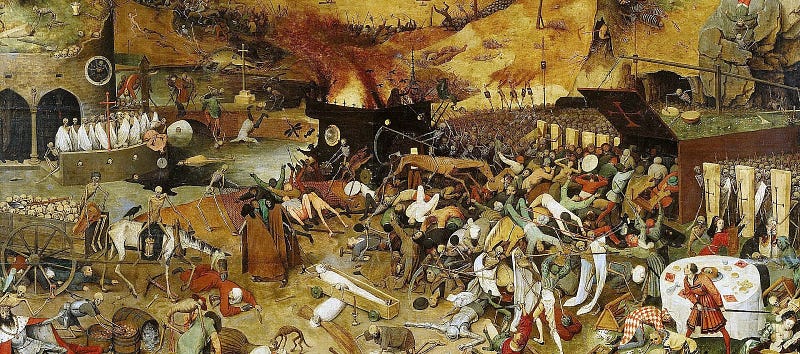Surviving the Plague: How Evolution Gave Us Autoimmune Diseases
Written on
Chapter 1: The Bubonic Plague's Grasp
In the year 1347, Pope Clement VI found himself in a palace filled with the crackling sounds of two enormous bonfires. As the flames provided warmth to his weary face, he offered prayers, hoping the fire would shield him from the relentless plague terrorizing Avignon.
Outside the protective glow, the once-vibrant streets were eerily silent, their liveliness replaced by an unsettling quiet, interrupted only by distant wails of despair. Within the confines of their homes, plague sufferers endured a slow, agonizing demise characterized by fever, chills, extreme fatigue, and delirium, culminating in painful, swollen lymph nodes known as buboes. This illness, dubbed the bubonic plague, derived its name from these telltale signs.
As the plague advanced through Europe, Avignon became a grim site where corpses were stacked high in hastily dug graves. The death toll escalated so rapidly that gravediggers struggled to keep up. One chronicler noted, “The stench from the mass graves was so overwhelming that passersby could scarcely approach a churchyard.” Eventually, Pope Clement consecrated the Rhône River, allowing bodies to be cast into its waters for a proper Christian burial.
Physicians donned long robes and beaked masks stuffed with flowers, convinced that the pleasant aromas would protect them from the “miasma” — the foul odors believed to spread the disease.

Chapter 2: Misplaced Blame and the Real Culprit
Many attributed the plague to divine punishment, while others targeted foreigners, particularly Jews, or those with differing beliefs. Yet, amidst the finger-pointing, the true antagonist was a minuscule adversary, Yersinia pestis (Y. pestis) — the bacterium responsible for the plague that thrived in the intestines of fleas.
Fleas proved to be ideal vectors for this deadly disease, stealthily hitching rides on rodents, cats, dogs, and even humans before biting and transmitting the infection. Between 1347 and 1351, it is estimated that 30–60% of Europe’s population perished from the bubonic plague.
Nonetheless, within this horrific narrative, there was a silver lining: half of the population survived, and many of them are your ancestors. They passed down a genetic variant that provided enhanced immunity against future bubonic plague outbreaks. (And yes, the bubonic plague persists today but is easily treatable with antibiotics if diagnosed promptly.)
Chapter 3: The Dual Nature of Natural Selection
However, nature can be unpredictable. This beneficial gene variant also carried with it a hidden curse.
Throughout human history, we have faced various infectious diseases that have exerted evolutionary pressures, prompting adaptations for survival and reproduction. For instance, in malaria-endemic regions, individuals with a genetic mutation for sickle cell anemia enjoy a survival advantage because their altered red blood cells create an inhospitable environment for the malaria parasite. Although sickle cell anemia poses significant health risks, those with one copy of the gene (heterozygotes) are less likely to experience severe malaria symptoms.
In essence, natural selection sometimes favors the survival of one ailment over another, deeming malaria more severe than sickle cell anemia.
Your ancestors also evolved specific genetic traits that enhanced their survival chances, passing these traits down to future generations. Over time, the prevalence of these protective genetic variants increased, a fundamental aspect of evolution known as natural selection.
Section 3.1: The Unintended Consequences of Evolution
Recent research has focused on DNA from over 516 Europeans who lived during the bubonic plague. The findings revealed four mutations that became more common in the years following the outbreak. One notable mutation involves the ERAP2 gene, an enzyme that offers resistance against deadly infectious diseases. Unfortunately, this same mutation is associated with autoimmune conditions such as rheumatoid arthritis, lupus, and Crohn’s disease.
Crohn’s disease, along with its counterpart ulcerative colitis, falls under the category of inflammatory bowel diseases (IBD). Individuals with these autoimmune disorders experience hyperactive immune systems that mistakenly attack beneficial gut bacteria, leading to inflammation of the digestive tract. Lupus patients face even graver challenges, as their immune systems can target any organ in the body.
As autoimmune diseases rise, over 50 million people in the U.S. are affected, making it the third most prevalent class of diseases after cancer and heart disease. Notably, 80% of those with autoimmune diseases are women, though the reasons for this are still unclear. A genetic link to the XX chromosome, typically present in biological females, is suspected.
Natural selection has historically favored adaptations such as Darwin’s finches developing larger beaks or naked mole rats opting for hairlessness. Yet, in some cases, it appears natural selection aids a species' survival only to inflict suffering on their descendants.
On particularly tough days, the thought of dealing with pus-filled buboes might seem preferable to grappling with ulcerative colitis. Anyone suffering from an autoimmune condition may share this sentiment. Unlike fatal diseases, autoimmune disorders represent a prolonged struggle without the release of death.
If this sounds exaggerated, you may not carry this troublesome gene variant. However, if you are one of the 50 million individuals battling an autoimmune disease, you might find yourself thanking your distant ancestors for their survival during the plague. It was the least they could do.

Chapter 4: Modern Insights and Historical Perspectives
This video discusses how autoimmune diseases may trace their roots back to the survival of individuals during the bubonic plague, shedding light on the historical context of modern health issues.
This presentation explores the connection between the Black Death and the evolution of immunity genes, providing insights into how past pandemics shape our health today.
Carlyn Beccia is an award-winning author and illustrator of 13 books. Subscribe to Conversations with Carlyn for free content every Wednesday or become a paid subscriber to access exclusive content on Sundays.